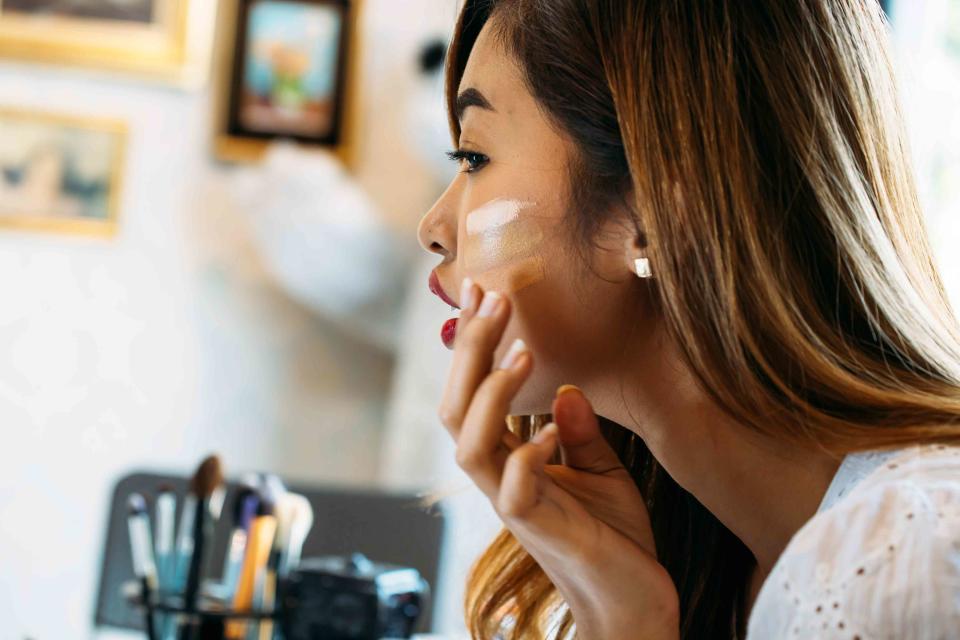Here's Why Your Makeup Is Pilling — And What to Do About It
A little prevention can go a long way.

Getty Images
Makeup can enhance your appearance, make you feel more confident, and — best of all — gives you an opportunity to have some creativity and fun with your look. So if your makeup pills (that’s when you see your coverage has turned into little balls on your skin), it’s easy to get frustrated and discouraged.
Plus, it’s possible that even when you switch your foundation, your makeup still pills. So, what gives? It turns out it’s not exactly your coverage alone to blame. Our experts break down why pilling occurs and how to prevent it.
Related: How to Use a Makeup Sponge to Apply Foundation
Why Does Makeup Pill?
When pilling occurs, chances are it’ll be obvious: “Skin pilling becomes prevalent as soon as your makeup is applied — your foundation turns into tiny beads or balls on the surface of the skin,” says Naseeha Khan, makeup artist and co-founder of CTZN Cosmetics.
Pilling can also be more subtle, and make your skin texture look uneven, rough, or bumpy. “It can sometimes look like peeling skin, especially if the makeup has a tint that’s close to your skin color,” adds Sarah Villafranco, founder and CEO of Osmia. "It feels like little granules under your fingertips."
It happens for several reasons:
Your products or ingredients aren’t compatible: “For example, you’re using a water-based product on top of an oil-based one,” says Suchismita (Tia) Paul, MD, a board-certified dermatologist in Orange County, California.
Incorrect skincare application: If you apply a thick moisturizer before a thinner product like a face serum, your serum may sit on top of your skin.
Overdoing your skincare: “Too many products — or applying too much of them—limits the ability of the skin to absorb them, resulting in pilling,” says Dr. Paul. “If your routine involves 12 products, at some point, the products are just interacting with each other rather than with your skin,” adds Villafranco.
Rushing through your routine: “Pilling can occur when individuals apply too much moisturizer or layer too many products on top of one another without giving the skin enough time to allow cream or serum to sink into the skin before applying foundation,” says Khan.
Unfortunately, once your makeup has pilled, there’s no real saving it. “It’s beneficial to start over rather than spend time trying to pick off the little pills,” says Khan.
How to Prevent Pilling
The upside to pilling happening to you is that avoiding it for the future is pretty straightforward.
Start with clean skin
“Make sure your face is thoroughly cleansed before applying skincare and makeup. Murad Soothing Oat and Peptide Cleanser is a creamy, ultra-gentle micellar cleanser that washes away dirt, oil, and residue while leaving beneficial moisture intact,” says Dr. Paul.
Follow up with a chemical exfoliant to slough away dead skin cells to make it easier for your skincare products to absorb. Or use a multipurpose product, such as Fenty Skin Cherry Dub Superfine Daily Cleansing Face Scrub, to gently polish and refine skin as you cleanse.
Related: 7 Expert Tips on How to Apply Makeup on Dry Skin and Avoid Flakes
Consider the ingredients
While they’re a popular ingredient in skincare (particularly in makeup primers) for their smoothing effect, “silicones such as dimethicone or cyclopentasiloxane can result in pilling when used excessively or when they are not compatible with other ingredients,” says Dr. Paul.
“The same can happen with rich mineral sunscreens, petroleum products like mineral oil, or high concentrations of high-molecular-weight hyaluronic acid, as you might find in a sheet mask,” says Villafranco.
So, choose lightweight formulas for both your skincare and makeup products. Or, alternate the timing of when you use certain ingredients — for instance, use your thick emollients in your p.m. routine when you’re not wearing makeup to bed.
Layer skincare correctly
On that note, while routines obviously will vary depending on your skin type and concerns, “generally, the correct order of skincare products is to layer them from thinnest to thickest consistencies,” says Dr. Paul. In other words, start with water-based products like serums and then move to creamy or oil-based ones.
Apply products with care
Whether it’s your moisturizer or your foundation, in many cases, a little will go a long way. Start with a tiny amount of product and evaluate from there. It’s easier to layer more if needed than take it away.
On top of that, how you apply products is also important to reduce the chance of pilling. “Avoid excessively rubbing in your skincare products because the friction can worsen pilling,” says Dr. Paul. Then, use a damp makeup sponge or brush to blend in makeup.
Take your time
If you’re rushing through your skincare routine, you’re just smearing the previous product right off. “Allow sufficient time for products to absorb or dry before adding another layer,” says Dr. Paul. A minute or two in between skincare layers should be sufficient. “Then wait at least five minutes before following it with makeup,” says Villafranco.
Related: The Exact Order You Should Apply All Your Makeup
For more InStyle news, make sure to sign up for our newsletter!
Read the original article on InStyle.

